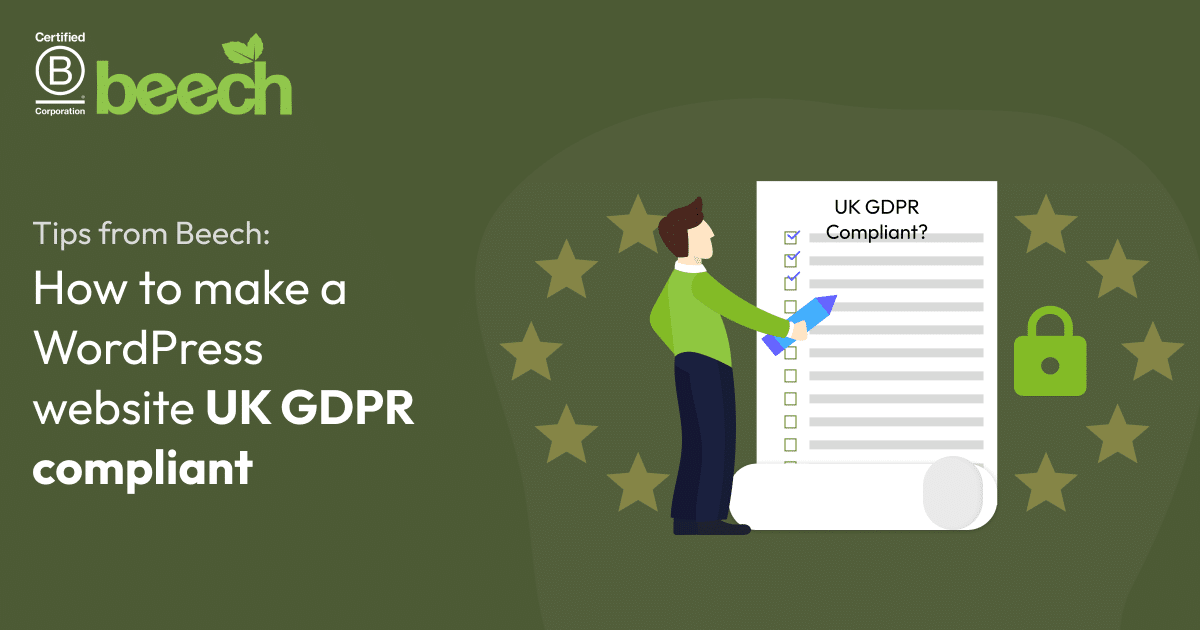If your organisation has a website that collects any personal information from UK visitors, including email addresses, names, IP addresses, or browsing behaviour, you need to understand website UK GDPR requirements.
It might sound technical and overwhelming, but at its core, it’s about treating your visitors’ data with respect.
GDPR vs. UK GDPR
Since Brexit, the UK operates under UK GDPR, which closely mirrors the European Union’s General Data Protection Regulation (GDPR). The key difference between UK and EU GDPR is that UK GDPR compliance is enforced independently by the Information Commissioner’s Office (ICO), rather than EU authorities.
However, the principles remain the same: protecting people’s personal data and giving them control over how their information is used.
In this post, we’ll share some guidance on how to make a WordPress website UK GDPR compliant, including answering questions around compliance for UK organisations.
What is UK GDPR in a website?
UK GDPR for a website is about being transparent and trustworthy. It means asking visitors for permission before collecting their data, explaining clearly what you’re doing with it, and making it easy for them to access, change, or delete their information whenever they want.
If someone visits your website and submits their email address or fills out a contact form, you’re responsible for keeping that information safe and using it only for the purpose they agreed to.
The core principles of UK GDPR compliance are the following:
- Lawfulness, fairness and transparency
- Purpose limitation
- Data minimisation
- Accuracy
- Storage limitation
- Integrity and confidentiality (security)
- Accountability.
With these principles, when looking at website UK GDPR specifically, we focus on consent, transparency, maintaining visitor’s rights over their data, high security and accountability, including reporting any breaches and demonstrating that we can follow the rules of these regulations.
Does UK GDPR apply to my website?
If your website collects any personal data at all, then yes, UK GDPR applies to you. This covers everything from contact forms and newsletter signups to analytics tracking and cookies. Even for small businesses or a non-profits, if you’re processing personal information, you need to be compliant.
And here’s something else important to consider…
If your website offers products or services to people in the EU or tracks their behaviour, you’ll also need to comply with EU GDPR, not just the UK version. For this reason, it’s worth considering your audience when you’re planning your compliance approach.
Who is responsible for ensuring UK GDPR compliance?
While the Information Commissioner’s Office (ICO) is responsible for enforcing UK GDPR, businesses themselves are primarily responsible for ensuring their own compliance.
This includes:
- Registering with the ICO and providing relevant data including names, addresses and the type of processing carried out by the organisation.
- Implementing policies and procedures to protect the personal data of their customers or clients, including all website visitors
- Appointing a responsible person or Data Protection Officer if their organisation’s data processing requires this
- Reporting any data breaches to the ICO within 72 hours of becoming aware of the incident, and informing individuals whose data is compromised if it’s considered a high risk of affecting their rights.

What happens if an organisation isn’t compliant with website UK GDPR?
Non-compliance with website UK GDPR means that an organisation isn’t fully compliant with UK GDPR regulations, for which the consequences can be severe.
Non-compliance can result in fines of up to £17.5 million or 4% of annual global turnover, whichever is higher, making UK GDPR compliance, and with this, website UK GDPR, essential for any business operating online.
Other potential consequences for organisations can include warnings, reprimands, and temporary or permanent bans on data processing from the ICO directly.
Outside of authorities, not complying with website UK GDPR can also result in a loss of customer trust and damage to the brand’s reputation.
A report in January 2025 from Marketing Dive stated that “Despite privacy being a major concern for both marketers and consumers, 75% of the most visited websites in the U.S. and Europe are not compliant with two major privacy regulations, according to recent research.”
When considering the potential consequences of non-compliance, and just how many organisations are falling through the cracks of data privacy, having the right measures in place is not only necessary, but can also positively impact how target audiences receive your brand.
So, how do we know if our WordPress websites are compliant?
How to ensure my website is UK GDPR compliant?
Start with a strong privacy policy
Your privacy policy is the foundation to being compliant with website GDPR in the UK. A privacy policy should:
- Be easy to find, usually linked in the footer of your website is a good position and recognised by visitors as common placement for policies
- Be written in plain, easy-to-understand language that avoids confusing legal jargon.
- Be transparent. It should cover what data you collect, why you need it, how you’ll use it, who might see it, and how long you’ll keep it.
We offer a policy template for organisations looking to stay compliant, request it here.
Always ask for consent
Never assume that website visitors want to be contacted or tracked. For any communications, or handling and storing of data, be sure to obtain their clear permission first. Use consent forms for cookies, newsletters, and any marketing communications. Doing this also means that when someone actively chooses to engage with you, you’ll know it’s their decision, making them a much more valuable lead.
The best way to ensure you’re compliant here is to map everywhere your website collects data. Walk through your website and identify everywhere you’re collecting personal data. This might include contact forms, comment sections, email subscriptions, analytics tools, payment processors, or chatbots. For each one, make sure you have appropriate consent and that people know it’s happening.
Grant visitors control over their cookies
When visiting a website, do you always click ‘Accept all’ on that pop-up?
It can be inconvenient when it pops up when we’re trying to browse, but it’s a choice we should be happy to make. Which is why cookie notices are so important.
Cookies are small text files that websites use to remember information about visitors, such as login details, shopping cart contents, and preferences. Using cookies promotes a better individual user experience by keeping visitors logged in and personalising their content, while also helping website owners analyse user behaviour. In some cases, cookies also track browsing habits for personalised advertising across different websites.
But not everyone wants them.
To comply with website UK GDPR, add a clear cookie notice to your website that explains what cookies you’re using and why. Give people the ability to opt in, opt out, or manage cookie preferences individually, and use clear messaging and an obvious pop-up so visitors aren’t feeling tricked into acceptance.
It’s also essential that for WordPress websites, we use the right cookie plugin, to ensure no data is tracked by the website until after the visitor clicks accept!
And don’t forget to add a dedicated cookie policy alongside that UK GDPR compliant privacy policy in your footer.
Keep your website secure
Security isn’t optional. Use an SSL certificate to encrypt data in transit, enable HTTPS on your website, and consider two-factor authentication for admin access.
As well as this, regularly keep your WordPress core, themes, and plugins updated, as many security vulnerabilities come from outdated software.
Ask us about website maintenance and support here.
This also includes keeping a website secure from within the organisation, too. Using access rights and permissions ensures only the people who genuinely need access to customer data should have it.
Use role-based access controls in WordPress to limit who can see what. This is especially important if you have team members who don’t need to view sensitive information and gives customers peace of mind that everyone isn’t seeing their data.
For WordPress websites, you can also add a security plugin that helps with this, including hiding the backend of the website from malicious attackers trying to gain access. Read this blog about website security for more on this.

Be website UK GDPR Compliant and stick to it!
To summarise, there are various things we need to do as website owners to ensure our website is compliant with UK GDPR, for the good of our visitors, and our brand.
Remember, UK GDPR isn’t something to follow once and then forget about. Regulations evolve, and so do your business practices. Review policies regularly and update them when things change, update website software on a frequent basis and check with your customers when handling their data. What you collected last year might be different from what you need this year.
Also, remember to regularly clear data from your website to ensure nothing is kept longer than it’s required. Create retention policies and removal schedules to help stay on track.
Compliance with UK GDPR might feel like a burden, but it’s actually an investment in building a trustworthy relationship with your audience. People are increasingly aware of data privacy, and they respect businesses that take it seriously.
If you’re wondering how compliant your WordPress website is, request a website healthcheck from us, which includes a check on data security.








